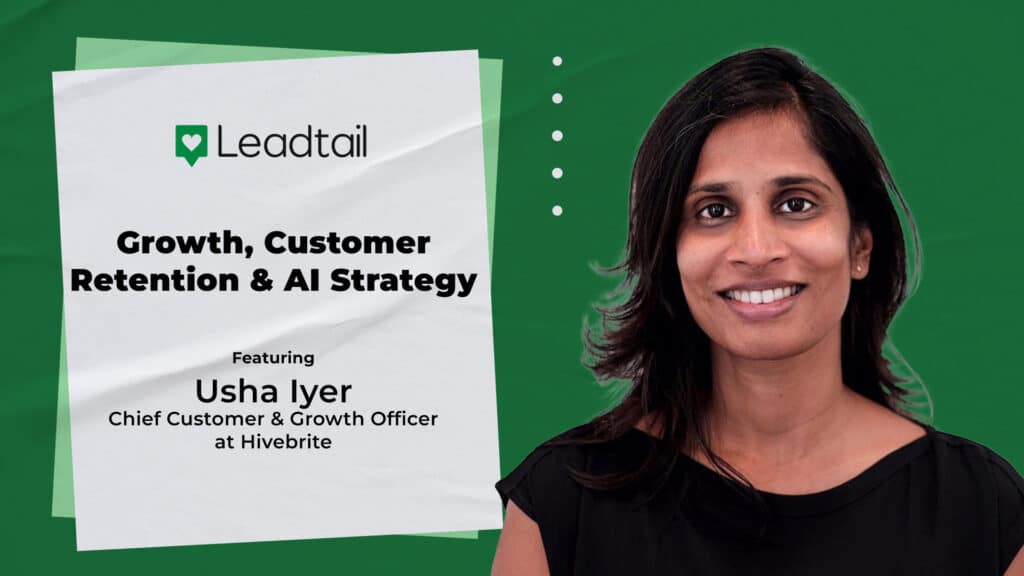The path to sustainable growth is a constant challenge. How do you move beyond the “hustle” of winning new clients to building a repeatable, scalable business?
We explored this question and many others with Usha Iyer, Chief Customer & Growth Officer, President at Hivebrite, on our Leadtail podcast, “Tomorrow’s Best Practices, Today.”
Here are five key takeaways from our conversation with Usha.
1. The Perils of “Growth at All Costs”
Many startups begin with a relentless pursuit of rapid growth, often by acquiring “any and every customer that comes away”. Usha shared that Highbright, in its early days, was no different.
They amassed nearly 200 small-to-medium business (SMB) customers and were generating less than $2 million in recurring revenue when they realized this approach wasn’t sustainable. The initial sprint for growth, while necessary for momentum, can lead to a scattered customer base and a lack of repeatability.
The turning point was a strategic decision to pivot and move upmarket, shifting from being an SMB provider to a solution for mid- and large-sized enterprises.
This pivot, though a learning process with both fast and slow adjustments, ultimately helped them identify their Ideal Customer Profile (ICP).
For startups, this is a critical lesson. Chasing every lead can dilute your services and stretch your resources thin.
By deliberately defining your ICP and focusing on specific use cases where your services can deliver the most value, you can build a more deliberate and repeatable growth engine.
This intentionality allows you to say “no” to customers who aren’t the right fit, which Usha emphasized was a key learning experience.
2. The Power of Intentionality and Data-Driven Segmentation
Once you define your ICP, you can begin a deliberate segmentation exercise. Usha identified specific use cases, narrowed the focus, and became more intentional about the target audience. This is an ongoing process of testing, gathering data, and refining their go-to-market framework.
The segmentation framework informs every part of the go-to-market machine, from marketing messaging to sales processes and customer engagement. For example, you can attract buyers by messaging problem statements that resonate with their use cases.
This data is then tagged and categorized for analysis. While AI has made this process easier, Usha noted that you still need to build metadata around the information you’re generating to make it actionable.
This intentional use of data extends beyond sales. integrating information from their customer success platform and Salesforce into a central AI repository provided visibility into the entire customer lifecycle.
3. The Human Element: Augmenting Data with Emotion
While data is crucial for objectivity, Usha made a compelling point: “data lacks emotion”. It’s easy to analyze metrics, but true understanding comes from pairing data with a culture of customer care. This ensures company leaders and team members at all levels stay close to the customer.
Usha gave a powerful example of the design team, which, despite having many responsibilities, takes the time to fine-tune their customers’ communities.
This hands-on involvement on the front line brings emotion and context to the data, reinforcing a culture where everyone genuinely cares about the impact they are creating.
For early-stage marketers, this means not just analyzing customer performance data but also maintaining a deep partnership with your early customers, understanding their emotional journey, and celebrating their successes with them.
4. The Importance of Pricing and Onboarding
Before a customer is successfully onboarded, Usha emphasized the importance of getting pricing and packaging right. She referenced the concept of a “price and value equilibrium,” where the price must be commensurate with the value provided.
This may mean allowing buyers at different stages to “right-size” their purchases, making it easy for them to buy.
This is a critical consideration for early-stage marketers. Offering flexible packages that meet prospects where they are can facilitate an easier buying process and build a foundation for future expansion.
The most critical step, however, is onboarding. The first few months are crucial for a customer to get to their “first point of value quickly”.
Usha highlighted the practice of sharing best practices from similar customers with similar use cases to guide new customers and prevent them from trying to “run before they can walk”.
The onboarding team’s role is not just support but is consultative, helping the customer adopt the product in the best possible way and setting them up for long-term success. This is a strategy that drives customer retention and opens up opportunities for expansion down the line.
5. Building a Culture of Intentionality and Alignment
The central theme throughout the conversation was intentionality. Usha and her leadership team are deliberate about how they meet, distinguishing between meetings for strategy, financial planning, and running the business.
They also ensure every leader is a customer-first thinker and an executive sponsor for key customer accounts. This customer-centricity, Usha believes, keeps them all aligned.
To scale this culture, Usha stressed the importance of building a “next level leadership team” that can serve as an extension of the C-suite. This delegation, combined with accountability, ensures that the company’s values are executed throughout the organization.
While “go-to-market alignment is driven by processes and data,” cultural alignment is built through people.
By fostering a collaborative spirit among this second tier of leadership, you can ensure that the right attitudes and ideas are growing, even when you’re not there to guide every decision.
You can watch the full video conversation here to gain even more insights into your “go-to-market” approach.
